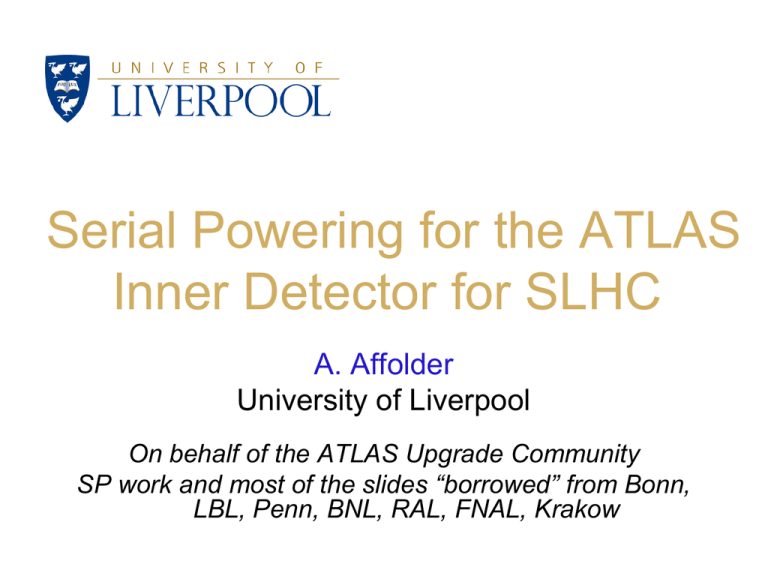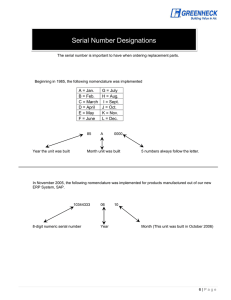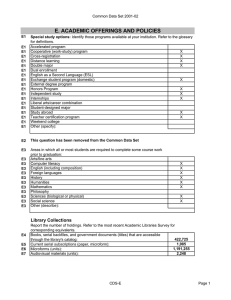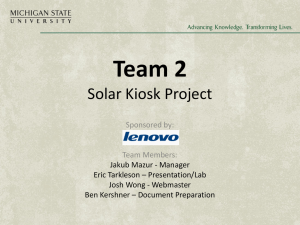Serial Powering for the ATLAS Inner Detector for SLHC
advertisement

Serial Powering for the ATLAS Inner Detector for SLHC A. Affolder University of Liverpool On behalf of the ATLAS Upgrade Community SP work and most of the slides “borrowed” from Bonn, LBL, Penn, BNL, RAL, FNAL, Krakow ATLAS Phase II Tracker Upgrade ATLAS Does Estimates up to few 1016particles/cm2 Gives Grad (10MGy) doses to components Barrel Pixel Tracker Layers: Short Strip (2.4 cm) -strips (stereo layers): Long Strip (9.6 cm) -strips (stereo layers): r = 3.7cm, 7.5cm, 15cm, 21cm r = 38cm, 50cm, 62cm r = 74cm, 100cm A. Affolder – Serial Powering at the SLHC 2 ATLAS pixels powering ATLAS LHC sLHC FE channels: ~80M Total FE power: 6.7kW Total FE current: 3.8kA @LHC: independent powering x5-6 granularity x2 power x3 current 20% efficiency Very massive services ~455M 12.3kW 11kA High x/X0%, saturated cable channels @sLHC Independent powering is unfeasible! Need to transmit power at low currents lower Vdrop ATLAS inner det. material distribution (incl. IBL) Higher power efficiency Reduced cables cross section Serial powering or DC-DC conversion A. Affolder – Serial Powering at the SLHC 3 Why Choose Serial Powering? ATLAS Consider n hybrids with: The power consumed by n hybrids is always n I V, but the power wasted in cabling depends upon the powering scheme! hybrid current I hybrid voltage V off-detector cable resistance R DC-DC gain g and define x= IR/V for x = 6 (2.5A * 3.5 Ω / 1.5 V) SLHC SP Ism SLHC IP 1.00 X Target: 24 Efficiency 0.80 0.60 0.40 0.20 0.00 1 5 9 13 17 21 25 Vdrop Vsm Pcab Efficiency: Psm/Ptotal IP nI IR V nI2R 1/[1 + x] PP nI nIR V n2 I2R 1/[1 + nx] SP I IR nV I2R 1/[1 + x/n] DCDC nI g nIR g gV n2I2R g2 1 [1 + xn/g2] 29 num ber of m odules 10 modules in series increases efficiency by factor 4 => Low V bad, large R and I are bad Values of these inputs are very system dependent. To get best results, they have to be considered at the design stages of ASICs, services, supports,…. A. Affolder – Serial Powering at the SLHC 4 Serial Powering Concept – – Benefits: • Low input current • Higher power efficiency (70-85% for systems) • Low material budget (extra ~0.03% radiation length for strips, excluding bus tape traces) • Simple, needs minimal external components • Highly flexible to changes to current/voltage after design Requirements: • Constant current source • More complicated ground referencing • AC coupled Data & Control • Over-voltage and Open Protection • Module/Chip Bypass (Slow and automated) Vab/I = Zmodule I hyb/module a I hyb/module Variable Z Serial Power - One cable powers „n‟ modules each with an equal current. Regulators • SHUNT ATLAS Module MC +nFEIC‟s Module MC +nFEIC‟s Regulated ASIC Voltages ( ABC‟s etc. ) Module MC +nFEIC‟s b Vb = Module Reference Constant Current Source A good references for both Serial Power and for DCDC The ATLAS – CMS Power Working Group Meetings 2011-https://indico.cern.ch/conferenceDisplay.py?confId=127662 2010-http://indico.cern.ch/conferenceDisplay.py?confId=85278 A. Affolder – Serial Powering at the SLHC 5 Two Shunt Layouts Iin[mA] Rslope Vout Iin without resistor 750 M2 - Vref M1 Rload 500 Vin Vout R3 - Isupply M1 A1 + R1 Vref with resistor + Iin - ATLAS A2 + R2 R1 250 M3 Ishunt + Iload 0 0 0.5 1 Distributed shunt w/degraded IV characteristics • – – – • • 1.5 2 Vout[V] M4 Iout A3 “Equivalent circuit” is a Zener diode Resistor degrades IV characteristic to solve shunt turn-on mismatch issues 1 regulator circuit per hybrid 1 protection circuit per hybrid Two voltages required generated by 1 or 2 LDOs on ASIC after shunt Already used in pixel FEI3 demostrator and strip ABCn 250 nm prototype chip One of the possibilities for strip upgrade M5 M6 Distributed shunt/LDO • Shunts in each FE ASICs – – R2 - Iout Combined shunt/LDO pairs in parallel for each FE ASICs – – – – • • “Equivalent circuit” is a resistor Resolves shunt turn-on mismatch issues Two voltages required generated by 2 ShuntLDOs in parallel in each ASIC o Tunable voltage on both outputs 1 protection circuit per hybrid Verified in 130 nm MPW submission and included and under test 130 nm FEI4 prototype pixel ASIC One of the possibilities for IBL and phase II pixels A. Affolder – Serial Powering at the SLHC 6 Chip Summary ATLAS Currently In Layout ABCN (250 nm) ABCN (130 nm) FEI4 (130 nm) Number Channel Per Chip 128 256 26880 Number of Chips per Hybrid 20 10 4 Number of Hybrids per Chain 8-24 24-30 10-12 Digital, Analogue Voltages 2.5 V, 2.2 V 0.9 V, 1.2 V 1.2 V, 1.5 V Digital, Analogue Currents 92 mA, 90 mA 60 mA, 102 mA 150 mA, 360 mA Current in Chain 5 A (3.6 A) 2.2 A 2.4 A Strip studies shown use ABCN (250 m) Pixel studies shown use FEI4 (130 m) A. Affolder – Serial Powering at the SLHC 7 SP Strip Stave Architecture ATLAS 24-30 hybrids in series, each at different potential wrt GND Common GND at end of stave Clock and command AC coupled at hybrid DATA AC coupled at end of stave • Hybrid with Distributed Shunt • • Use one external shunt regulator and external SP protection Use each ABCN‟s integrated shunt transistor(s) – Two (redundant) shunt transistors, 140mA each A. Affolder – Serial Powering at the SLHC 8 ATLAS Serial Power Control Circuit Vhybrid Vraw Ref Power current path distributed among ABCn chips. No interruption. Highly redundant. No chip shunts more than 200mA. Cntrl 1 Cntrl 2 ABCn ABCn ABCn ABCn ABCn ABCn ABCn ABCn ABCn ABCn ABCn ABCn ABCn ABCn External feedback control loop sets ABCn ABCn ABCn ABCn Average current to desired value. ABCn ABCn Each FEIC participates in current shunting ABCn ABCn Heat load differences should be less than ABCn ABCn Regulator OPAMP monitors Vraw Drop for whole module 2% chip to chip. A. Affolder – Serial Powering at the SLHC 9 Strip Electrical Test Vectors ATLAS • Frame with plug-ins for early testing of: – – – – – Single Module Frames Serial Power Control Serial Power Protection (discrete or custom ASIC) DC-DC convertors Multi-drop AC-coupled LVDS clock/control Shielding/Grounding • 4 module devices for tests of: Stavelets – System powering effects DC-DC or Serial Power – Shielding/Grounding – Noise from AC-coupled MLVDS – DAQ development • Simplified full length devices for specialized tests – Multi-drop AC coupled LVDS – Simplified full staves Serial power protection A. Affolder – Serial Powering at the SLHC 10 Stave Hybrids ATLAS Two Cntrl Lines 5 Amps One A. Affolder – Serial Powering at the SLHC 11 Stave Module Noise Testing of module with both DCDC shields Cu wrapped ATLAS Hybrid 62 Hybrid 61 Serial Power Chain AC Cpupled Clock/Command Input noise: 590e Input noise: 599e Input noise: 588e 2.5V per hybrid, ~5V total across the module (using constant current source) One hybrid is DC referenced to sensor, the other AC Use BCC ASICs for digital communication (AC-coupled LVDS), powered from hybrid Serially powered module performs same as with parallel powering!!! Input noise: 599e Parallel Power Serial Power Hybrid 62 590e/596e 590e/599e Hybrid 61 585e/591e 588e/599e A. Affolder – Serial Powering at the SLHC 12 Stavelets ATLAS power and power control data and hybrid communication • Shielding, grounding, power, multi-drop LVDS Power Protection Board (PPB) allows each SP hybrid to be bypassed under DCS control Other powering options to be tested later Using Basic Control Chip (BCC) • Bus Cable First Stavelet serial powered with on-hybrid control • BCC PCBs Shortened Stave, built as electrical test-bed • EOS Card Serial Power Protection PCBs Generates 80MHz data clock from 40MHz BC clock 160Mbit/s multiplexed data per hybrid Readout using HSIO board from SLAC HSIO + interface A. Affolder – Serial Powering at the SLHC 13 ATLAS Serially Power Stavelet Noise Performance • Used on-hybrid shunt control circuit • Stavelet noise approaching single module tests Noise for 16 columns of chip on stavelet – Roughly ~20 e- higher • Plan to extend tests to other SP plug-in controllers (ASICs) as they become available • Still more work to go to get ultimate noise performance, but already acceptable for needed signal-to-noise A. Affolder – Serial Powering at the SLHC 14 Custom Constant Current Source ATLAS Custom Current Source 100 mA Benchtop PS 1 ms Current source is “stiffer” to ABCN25 current bump after trigger • Programmable current source has been prototyped • Designed for full-length stave, output up to 80V at 6A • Includes isolated USB interface and overvoltage protection/interlock A. Affolder – Serial Powering at the SLHC 15 ATLAS Serial Power Protection For first test, serial power protection circuit made with discrete components •One wire Addressable by Hybrid Serial Power Control • Installed on each of the 8 Stavelet Hybrids. • An SCR function allows autonomous shut down on Over Voltage Sense A. Affolder – Serial Powering at the SLHC 16 ATLAS Serial Power Protection Studies • Mimics 8 hybrids + protection + regulators – Mimics clock dependent current loads – Studies power-up issues • Tests real-time circuits; can induce controlled “open circuits” • Tests 1-wire bypass circuits Voltage fluctuations when a real-time bypass fires M-shunt board “Serial power protection for ATLAS silicon strip staves”, D. Lynn, et al., Nucl. Instr. and Meth. A 633 (2011) 51-60 A. Affolder – Serial Powering at the SLHC SPi board 17 Serial Powering Protection on Stavelet ATLAS • Hybrid bypassing works as expected – P=VI=100 mV*5 A=0.5 W – Noise slightly lower with neighbour‟s bypassed Constant Current Source at 5A, ODDS AND EVENS, Composite 0.5 W A. Affolder – Serial Powering at the SLHC 18 ATLAS Serial Power Protection ASIC Custom serial power protection ASIC (130 nm) is in design. Analogue only section prototyped in MPW under test “Serial Power & Protection (SPP) ASIC for 1 to 2.5V Hybrid Operation” http://indico.cern.ch/getFile.py/access?contribId=11&resId=0&materialId=slides&confId=85278 • Designed for use with 250 nm and 130 nm ABCNext – One wire control circuit supplies power to the SPP and controlled programmable shut down control o SPP chip has internal shunt regulator to set its voltage to 2.3V. – On chip band gap forms reference for SPP 2.3V and for hybrid voltage. – Hybrid voltage may be set from 1V to 2.5V – SCR for autonomous shut down for over voltage. o ~100 mV across hybrid with autonomous shutoff – On board shunt transistor available to guarantee hybrid switch off. o ~60 mV across hybrid with controlled shutoff CMOS 8RF A. Affolder – Serial Powering at the SLHC 19 Full-scale LVDS Test ATLAS • Need to determine “maximal” chain for clock/command using AC-coupled multi-drop LVDS • Designed/manufactured the Buffer Controller Chip (BCC) in 250 nm IBM to allow multi-module testing in a serial power chain – Developed by SLAC/UCL/Cambridge/LBNL – Generates 80 MHz data clock and multiplexes data lines – Replaced in final chip set by Hybrid Controller Chip (HCC) • Chain of 24 BCC operated as a system on the full length bus • Sufficient amplitudes and short enough rise time for all positions for BCC to regenerate clocks correctly A. Affolder – Serial Powering at the SLHC 20 One “Final” Envisioned Serial Power Architecture ATLAS •SPP directly attached to stave bus –Single Global power line supplies each SPP with independent power –SPP is addressable to turn “on” and “off” a hybrid. –Built in Transistor capable of shunting hybrid current independent of ASIC based shunt transistors –Includes serial power regulator and SCR circuit for overvoltage protection •Extra SCR on each hybrid in case of SPP failure •Shunt with LDOs in each ABCn to generate analogue/digital voltages Global SPP bus Power & addressable communications 1.5K @ 6mA SP- - + SCR - + SCR - Hybrid SCR 10 FEIC + 10 FEIC - Hybrid 10 FEIC SCR Hybrid + SPP SPP SPP SPP 10 FEIC SP+ SPP with Large ShortingTransistor on Services Bus Tape. (5cmX.6um) 63mV @1.6A - + Hybrid + ....... 24 or 30?? ....... HCC HCC HCC HCC A. Affolder – Serial Powering at the SLHC 21 Material Estimate for Serial Power ATLAS Using currently understanding, the radiation length of material needed to service power has been estimated – Excludes extra bus tape traces, support, traces Goal of less than 2% for a stave‟s radiation length • Serial Power: 1 shunt per ABCN, 1 control and 1 protection ASIC per hybrid – Estimate 0.03% of a radiation length to stave from serial power Mostly from extra needed hybrid area and AC-coupling capacitors 24 mm BCC replaced by bare die hybrid control chip (HCC) on each hybrid. 10 extra 0402 capacitors need for AC coupling clock/command/trigger Discrete serial power protection will be replaced with custom ASIC (3 mm2), 1 1206 resistor, and 4 0402 capacitors ~35 mm 7.8 mm Discrete shunt control on current hybrid will be replaced with custom ASIC (9 mm2), 2 0805 resistors, 2 0402 capacitors A. Affolder – Serial Powering at the SLHC 22 ATLAS Strip Serial Powering Conclusions • All technology needed for SP has been prototyped and shown to work (and compatible with 130 nm CMOS) – Remaining concerns are locations of devices and number of units in a SP chain (concerned with both common mode build-up and failures) • Largest continuous current channelled through any one ASIC will be les than 200 mA • Largest power dissipation in SP control/protection ASICs is less than 50 mW • Hybrid voltage regulation will have several amps of reserve current handling – Have shown up to 10 A in a hybrid – Allows flexibility for set voltages/currents • Minimal impact on material budget • Last bit for ultimate noise performance still under study – But measured noise would yield 15:1 S/N at end of life A. Affolder – Serial Powering at the SLHC 23 ATLAS Pixels SP Shunt-LDO – – – – – • M1 A1 M2 Vin Vout R1 R3 A2 M3 Ishunt Iload R2 M4 A3 Iout M5 M6 V-I characteristic of 2 Shunt-LDO in parallel @ different output voltages (MEASUREMENT RESULTS) Vout 1 Vout 2 Working principle and good performance demonstrated with 2 prototypes already – • Removed input series resistor for shunt improves power efficiency Shunt-LDO regulators can be placed in parallel without problems regarding mismatch & shunt current distribution Shunt-LDO having different output voltages can be placed in parallel Shunt-LDO can cope with an increased supply current if one FE-I4 does not contribute to the regulation Failed regulator loses one ASIC instead of one hybrid Vref - Advantages for Serial Power Iin + • Shunt transistor is part of the LDO load LDO power transistor works as an input series resistor for the shunt - – – + Combination of a LDO and a shunt transistor + • - ATLAS 130 nm MPW Nominal Power Efficiency of 2 Shunt-LDO in parallel with different Vout = 75% A. Affolder – Serial Powering at the SLHC 24 FEI4 Pixel ASIC ATLAS Voltage drop between chip and board ground Reg2 • Prototype FEI4 ASICs and packages undergoing first testing now • So far, Shunt-LDOs working as expected Reg2 Reg1 A. Affolder – Serial Powering at the SLHC 25 ATLAS • Phase II FEI4 Serial Powered Pixel Modules Cable prototype for serial power has made – 8 modules in chain on a stave • At module level, the current is routed in parallel to the 4 FE-I4s – Prototype module flex in production – I = Imod = 2.4A (max) • • 2 Shunt-LDO/FE to generate VDDA = 1.5 V and VDDD = 1.2 V per ASIC 8 Shunt-LDO regulators per module in parallel FE-I4 Module flex 1.5V Iin 1.2V FE-I4 1.5V 1.2V Shunt-LDO Shunt-LDO Shunt-LDO Shunt-LDO Shunt-LDO Shunt-LDO Shunt-LDO Shunt-LDO 1.5V 1.2V FE-I4 1.5V Iout 1.2V FE-I4 A. Affolder – Serial Powering at the SLHC 26 Pixel Module Protection Chip ATLAS • Chip ASIC in design – – • 130nm IBM Bypass transistor local VDD ADC Independent slow ctrl line & OV protection – • Iin DCS OV protection = Silicon controlled rectifier Mbp C1 D2 GND OV module C2 D3 Preliminary simulations: local GND Iout Slow ctrl Bypass Fast response DGNMOS W = 48mm L = 0.24µm Vgsbp Ibp AC-signal Vmod ~850mV Vmod Ibp C1 = 100nf C2 = Cgs = 33pf D1, D2 = PMOS Vgsbp ~850mV V (V) time (ms) I (A) V (V) D1 Imod time (ms) r (Ω) A. Affolder – Serial Powering at the SLHC 27 ATLAS Conclusions • Modification of power schemes necessary for SLHC Silicon Systems – Much high segmentations and larger areas • Serial powering has been shown to be a viable option – Low mass, higher power efficiency, simple, flexible • Two different systems are under test for ATLAS pixels and strip detector systems – So far, all results are positive – Still in serious consideration for final system A. Affolder – Serial Powering at the SLHC 28 BACKUP MATERIAL SPP – 12 Hybrid HSPICE simulations (Monte=10) Hybrid voltage (1.2v) 80mv when shorted Decode 0:unshort hybrid Decode 1: short hybrid Decode 1: short hybrid Decode 0: unshort hybrid A. Affolder – Serial Powering at the SLHC 30 SPP – 12 hybrid HSPICE simulations (Monte=10) Vglobal (25v) SPP pwr Load Current in one FE IC ABC 130 digital current ABC 130 analog current Hybrid voltage (1.2v) 80mv when shorted Decode 0: unshort hybrid Decode 1: short hybrid AC coupled pulse-width modulated signal A. Affolder – Serial Powering at the SLHC 31 Scaling up the Serial Powered System ATLAS The length of the SP chain and it‟s reverence connections needs careful examination under dynamic conditions as we begin to scale up from one module towards a full stave Simulation results Common Mode for Hybrid to EOS Signals The plot on the left shows a simulation result for a 12 hybrid SP loop when L1‟s are being issued (modeled as a 20% increase in digital current for all ABC chips.) The plot shows the local hybrid reference vs EOS ground. This represents one source of common mode noise in the digital signaling between the EOS and Hybrid. These simulations show a significant the potential for a growing common mode signal as the length of the SP chain is increased. Hybrid Coupling to the End of Stave Potential (Shield) 100 pF (stray) < 50mV ~ 150mV ~ 400mV A. Affolder – Serial Powering at the SLHC 100 nF < 50mV ~ 100mV ~ 100mV 32 Shunt Regulator (FE-I3 approach) Iin Rslope Vout - R1 Vref Isupply + R2 Iout Iin[mA] without resistor 750 500 250 0 0 0.5 1 1.5 2 • Shunt regulator generates a constant output M1 Rload voltage out of the current supply • current that is not drawn by the load is shunted by transistor M1 • Very steep voltage to current characteristic • Mismatch & process variation will with resistor lead to different Vref and Vout potentials • Most of the shunt current will flow to the regulator with lowest Vout potential • Potential risk of device break down at turn on Vout[V] • Using an input series resistor Slide reduces the slope of 33 A. Affolder – Serial Powering at the SLHC 33 the voltage to current characteristic ATLAS LDO Regulator (FE-I3 approach) Iin Rslope Vout1 Vin - R1 Isupply Vref - Vref M1 + Rload M1 + Vout 2 R1 R2 R2 Iout • Second supply voltage of lower potential is genareated by a LDO regulator powered by the shunt regulator • The LDO power transistor operates like a regulated series resistor which controls the voltage drop between • Change order of regulation chain input output voltage to a constant output voltage • Rhave SLOPE replaced by the LDO power transistor • Shunt transistor connected to the LDO output Sli ATLAS Shunt Regulator Architectures • Hybrid with Shunt “W” • • Use each ABCN‟s integrated shunt regulator Use each ABCN‟s integrated shunt transistor(s) See “Serial power circuitry in the ABC-Next and FE-I4 chips” to be given this afternoon by W. Dabrowski • Hybrid with Shunt “M” • • Use one external shunt regulator Use each ABCN‟s integrated shunt transistor(s) – Two (redundant) shunt transistors, 140mA each • Hybrid with SPi (or similar) • • Use one external shunt regulator Use one external power transistor See “The Serial Power Interface Chip”, to be given this afternoon by M. Trimpl Each option has its merits. All now available in silicon: final choice to be based upon test results. 35 Stave+Petal Programme ATLAS •Collaboration of more than 25 institutes from 5 countries Petal Hybrid •Designed to minimise material Early electrical systems tests needed to determine which masssaving changes possible • Requirements of automated assembly built in from the startSimplify build as much as possible!! • Minimize material in thermal management by shorting cooling path- Gluing module to a stave core with embedded pipes Stave Module Glue Glue • Design aims to be low cost- Minimize specialist components! No substrate or connectors ~ 1.2 meter Bus cable Hybrids Carbon fiber facing Carbon honeycomb or foam Coolant tube structure Readout IC’s A. Affolder – Serial Powering at the SLHC 36





